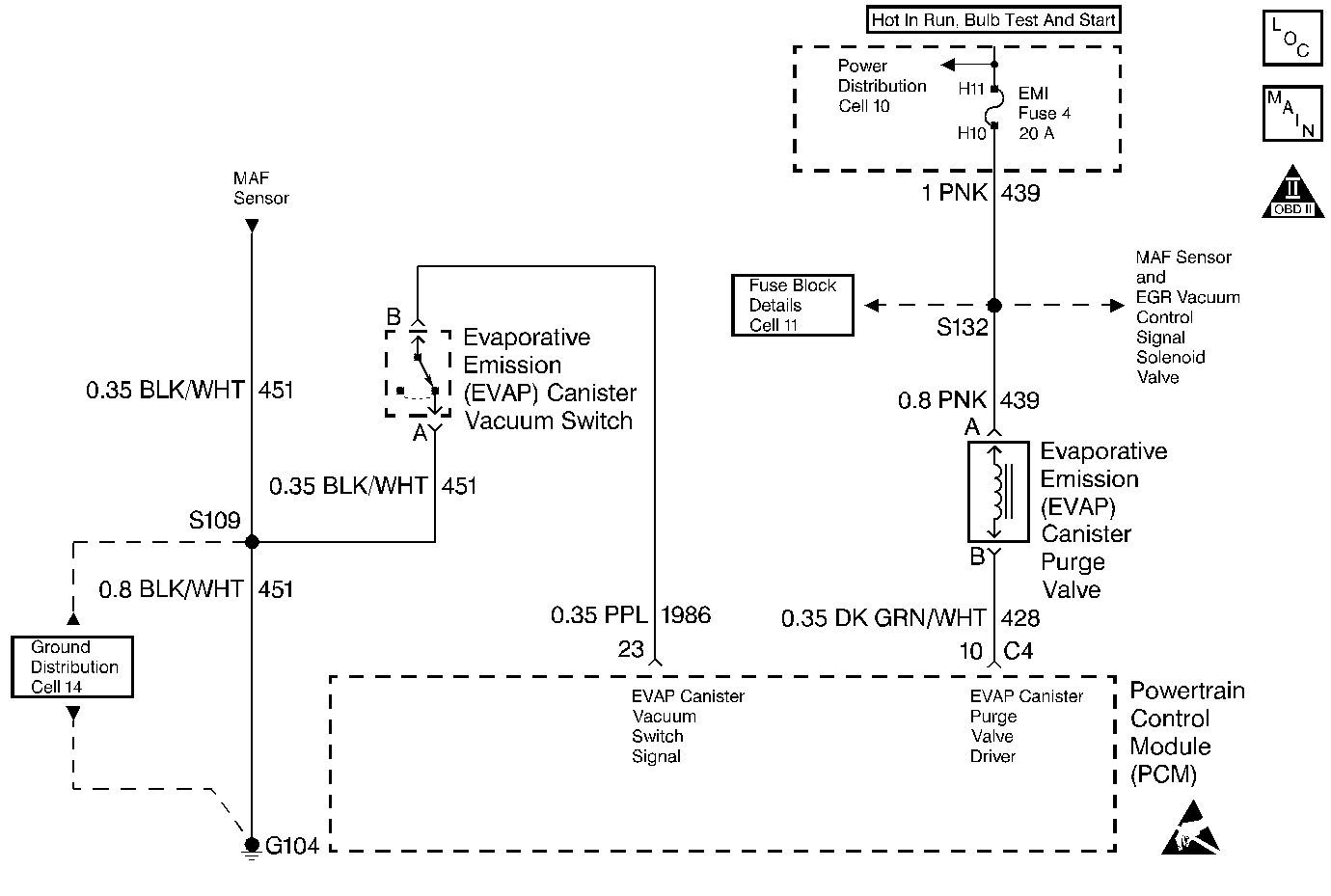
Circuit Description
Ignition voltage is supplied directly to the EVAP canister purge solenoid valve. The PCM controls the solenoid by grounding the control circuit via an internal switch called a driver. The primary function of the driver is to supply the ground for the component being controlled. Each driver has a fault line which is monitored by the PCM. When the PCM is commanding a component ON, the voltage of the control circuit should be low (near 0 volts). When the PCM is commanding the control circuit to a component OFF, the voltage potential of the circuit should be high (near battery voltage). If the fault detection circuit senses a voltage other than what is expected, the fault line status will change causing the DTC to set.
Conditions for Setting the DTC
| • | Engine speed greater than 600 RPM. |
| • | The PCM detects that the commanded state of the driver and the actual state of the control circuit do not match. |
| • | Condition must be present for a minimum of 25.5 seconds. |
Action Taken When the DTC Sets
| • | The PCM will illuminate the Malfunction Indicator Lamp (MIL) on the second consecutive drive trip that the diagnostic runs and fails. |
| • | The PCM will record operating conditions at the time the diagnostic fails. The first time the diagnostic fails, this information will be stored in Failure Records. If the diagnostic reports a failure on the second consecutive drive trip, the operating conditions at the time of failure will be written to Freeze Frame and the Failure record will be updated. |
Conditions for Clearing the MIL/DTC
| • | The PCM will turn the MIL OFF after three consecutive drive trips that the diagnostic runs and does not fail. |
| • | A last test failed (Current DTC) will clear when the diagnostic runs and does not fail. |
| • | A History DTC will clear after forty consecutive warm-up cycles, if no failures are reported by this or any other emission related diagnostic. |
| • | PCM battery voltage is interrupted. |
| • | Using a Scan tool. |
Diagnostic Aids
Using Freeze Frame and/or Failure Records data may aid in locating an intermittent condition. If the DTC cannot be duplicated, the information included in the Freeze Frame and/or Failure Records data can be useful in determining how many miles since the DTC set. The Fail Counter and Pass Counter can also be used to determine how many ignition cycles the diagnostic reported a pass and/or a fail. Operate vehicle within the same freeze frame conditions (RPM, load, vehicle speed, temperature etc.) that were noted. This will isolate when the DTC failed.
For intermittents, refer to Symptoms .
Test Description
Number(s) below refer to step numbers on the diagnostic table.
-
Listen for an audible click when the solenoid operates. Be sure that both the ON and the OFF states are commanded. Repeat the commands as necessary.
-
This check can detect a partially shorted coil which would cause excessive current flow. Leaving the circuit energized for 2 minutes allows the coil to warm up. When warm the coil may open (Amps drop to 0), or short (goes above .75 Amp).
-
If no trouble is found in the control circuit or the connection at the PCM, the PCM may be faulty, however, this is an extremely unlikely failure.
Step | Action | Value(s) | Yes | No |
|---|---|---|---|---|
1 | Was the Powertrain On-Board Diagnostic (OBD) System Check performed? | -- | ||
Does the solenoid turn ON and OFF with each command? | -- | |||
Does the current draw measure less than the specified value shown (but not 0)? | 0.75 A | Go to Diagnostic Aids | ||
4 |
Does the DVM display infinite resistance? | -- | ||
5 |
Does the test light turn ON and OFF with each command? | -- | ||
6 | With the test light connected to ground, probe the ignition feed circuit in the solenoid harness connector. Does the test light illuminate? | -- | ||
7 |
Does the solenoid operate? | -- | ||
8 | Check the connections at the solenoid. Was a problem found and corrected? | -- | ||
9 | Check the connections at the PCM. Was a problem found and corrected? | -- | ||
10 | Repair the faulty solenoid control circuit. Is the action complete? | -- | -- | |
11 | Repair the faulty solenoid ignition feed circuit. Is the action complete? | -- | -- | |
12 | Replace the solenoid Is the action complete? | -- | -- | |
|
Important:: Replacement PCM must be programmed. Refer to Powertrain Control Module Replacement/Programming . Replace the PCM. Is the action complete? | -- | -- | ||
14 |
Does the scan tool indicate that this test ran and passed? | -- | ||
15 | Using the scan tool, select Capture Info, Review Info. Are any DTCs displayed that have not been diagnosed? | -- | Go to the applicable DTC table | System OK |
